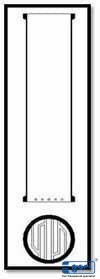
Glass Column:
In many operations like reaction, extraction & absorption, the transparency of the glass is a particular advantage. For such a process, a range of glass column components is available in Borosilicate glass.
Glass Fractional Distillation Column
A glass fractional distillation column is a type of glassware used in laboratories. It is used to separate a liquid mixture into its component parts, or fractions, by differential boiling points.
The liquid mixture is placed in the column, and heat is applied to the bottom of the column.
The vapor rises and is condensed on the glass beads, which act as a vapor barrier. The liquid then flows down the column and is collected in fractions.
Fractional distillation is commonly used in the chemical industry to purify chemicals, and it is also used in the oil industry to refine crude oil into useful products such as gasoline and diesel fuel.
Laboratory fractionating columns
Fractional distillation columns in the laboratory are generally simple glassware, consisting of a glass tube with a side arm for receiving the distillate. The column may be packed with glass beads, or it may be a bare glass tube.
The glass beads provide a large surface area for the vapor to condense, and they also help to keep the liquid from dripping down the column too quickly.
A fractionating column is often used in conjunction with a distillation flask, which is used to hold the liquid to be distilled. The distillation flask is placed on a hot plate, and the column is placed on top of the flask.
The column is filled with the liquid to be distilled, and the heat is turned on. As the liquid in the flask boils, the vapor rises up the column and condenses on the glass beads.
The liquid then flows down the column and is collected in fractions. The first fraction to come out of the column will be the lightest, and the last fraction will be the heaviest.
Fractional distillation is a very useful technique for separating mixtures of liquids, and it can be used to purify chemicals or refine crude oil.
Industrial Borosilicate Glass fractionating columns
Borosilicate glass is a type of glass that is used in many industrial applications. It is made of boric acid, silica, and other materials, and it is designed to be resistant to high temperatures and corrosive chemicals.
Borosilicate glass is used to make laboratory glassware, cookware, and bakeware. It is also used to make industrial containers, pipes, and tubing.
In the chemical industry, borosilicate glass is used to make reaction vessels, distillation columns, and storage tanks. In the oil industry, it is used to make pipeline coatings, refinery vessels, and heat exchangers.
Borosilicate glass has many advantages over other types of glass. It is stronger, more heat resistant, and more chemically resistant than other types of glass.
Borosilicate glass is made by adding boric oxide to the molten glass. Boric oxide is a white powder that is produced by fusing borax and colemanite.
Boric oxide gives the glass its strength, and it also makes the glass resistant to heat and corrosive chemicals.
Borosilicate glass is used in many different industries, and it has many advantages over other types of glass.
When choosing a fractionating column for your application, it is important to consider the types of liquids you will be using, the amount of heat that will be applied, and the corrosiveness of the chemicals involved.
Borosilicate glass is a good choice for many applications because it is strong, heat-resistant, and chemically resistant.
Advantages of Glass Column:
1. Insert to all chemicals hence no risk of contamination.
2. Transparency allows visual monitoring of the process, flow patterns, color changes, etc.
3. Almost universal resistance to corrosion.
4. Smooth surface permits easy cleaning and prevents fouling.
Glass Column Components








